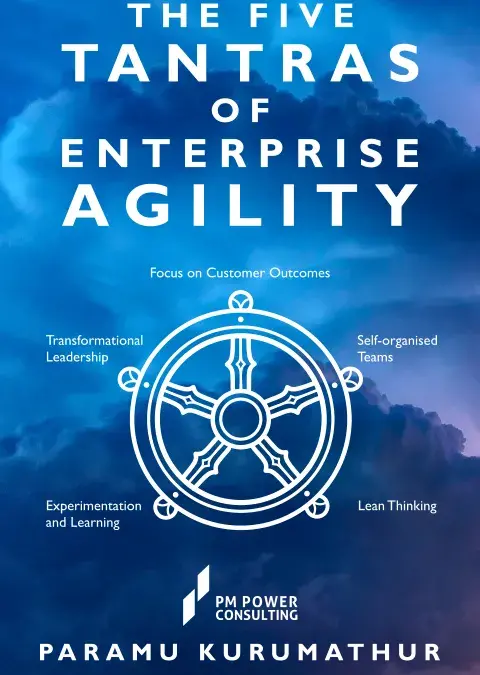Agile has caught the fancy of the world. It is now a force to reckon with in our rapidly changing business world. Development practices based on Agile have become the first choice of project managers and leaders across thousands of organisations worldwide. Time and again, Agile has proven to be more flexible and effective in responding to change than other, traditional approaches.
Becoming Agile and
sustaining it is difficult, yet deeply rewarding. With Agile, customers and stakeholders
get the best outcomes as they are engaged throughout in the process of
delivering continuous value to the customer. In an environment that is
continuously and rapidly changing, it is important that products change quickly
to keep up with the evolving needs of customers, and to outpace competition.
And being Agile allows for precisely this – quick changes to products. With its
focus on users and business value, Agile thinking has lived up to its promise
of being the most adaptive development approach in a turbulent and
ever-changing world.
Coaches of PM Power Consulting have, over the years, helped many organisations on their transformation journey towards becoming and being Agile. They have observed that this journey, to becoming Agile, is not smooth. There are many pitfalls along the way. Organisations do many things right, but sometimes fall into one of these pitfalls and struggle to move forward. Many organisations have successfully wended on this journey and arrived at their destination. Some have found the journey too tedious and have given up along the way. And, some organisations who have reached there and have become Agile, stay there for a while and then regress.
How do you ensure that
an organisation starting on its Agile journey has smooth sailing along the way
and a safe haven once it reached its destination? This book is the result of
putting together the experience and learnings of these PM Power coaches to help
organisations in exactly this. Reaching there and staying there.
This book, The Five Tantras of Enterprise Agility, is presented as the story of one such Agile transformation journey – the journey of an organisation representing many of the organisations that PM Power has engaged with as Agile coaches. A representative coach comes into this organisation about a year-and-a-half into their Agile transformation journey. He is chartered to assess how far and well this organisation has progressed on their Agile transformation. He notes at some of the good things they did, some of the new methods and practices they adopted; how they changed their culture and mindset, their leadership paradigms and their thinking on efficiencies and inefficiencies; how they changed their ways looking at learning and innovation; and how they organised themselves to meet all these challenges; and above all, how they changed their focus to delivering continuous value to the customer. He also notes some of the things that the organisation could have done differently and better in their journey – some amber signals that should have alerted them to a problem ahead.
This book is primarily
intended for leaders who are looking to take their organisations on the Agile
Transformation journey and managers who will drive this transformation. It will
alert them to what they can look forward to and what they need to look out for
on this journey. The book is also intended for change agents (coaches and
consultants) who help organisations progress on the transformation. The book will
add to their experience set that will help them advise their clients in the
best possible way. Project /
Program Managers, Scrum Masters and team members who are keen to play an
influential role in the organizational agile transformation process also will
be able to benefit from this book.
The objective of this
book is to help these people address the concerns of organizations
as they try to reap benefits of moving to Agile – in a specific sense, to
address the gap between an organization’s stakeholders’ expectations from Agile
(to meet business needs) and their real outcomes and to help the leadership of
organizations understand and implement agility at an organizational level (as
opposed to agility in teams and projects). The objective of this book is to
bring to the intended readers the wealth of experience and wisdom about Agile
and its implementation that coaches at PM Power have built up over the years.
The book is written in a conversational style as in our previous book. This makes it easier to read and certainly, to write. The hero coach of the book, Dr Vishnusharman employs a coaching style of conversation to understand what is going on and what needs to be done.
To drive home
some of the points, we have used fables, some from Panchatantra, some from
Aesop and some from the fertile imagination of the writer’s own mind.
The book is
divided into five main “books”. Each of the “books” looks at one Enterprise
Agile Transformation Value. These five values are: Focus on Customer Outcomes; Self-organisation; Transformational Leadership; Experimentation and Learning; and Lean Thinking.
In each of these books, we discuss five main aspects (in one chapter each) of internalising that particular value: the process of getting there or getting the value implemented; ensuring the right culture and mindset for
internalising this value; creating the right organisation for success
in implementing and sustaining this value; the role of leadership in implementing and
sustaining this value; and the tools and processes needed for this.
The book is a
compendium of what needs to be done, and done right, and what should be
avoided, or not done, on the journey to becoming Agile; and after having
reached there, staying Agile. The real focus is on being and staying Agile. At
the end of each book we give a summary list of the set of “amber signals”, or
the things that the organisation should have done or could have done better in
their transformation journey. Thus, the book contains both the good practices
that can be adopted during an organisation’s Agile Transformation journey and
the practices that need to be avoided.
At the very
end, the book has a chapter on being Agile in a forced dispersal environment,
caused by, for example, pandemics spread by the Corona Virus.
What is it that
this book has over other books on Agile? For one, it is based on the experience
of many experts in the Agile area. As mentioned before, PM Power Consulting has
over 20 experts who have, over many years, coached and consulted with various
types of organisations on their Agile Transformation journey. The inputs of all
these experts have been taken to arrive at the details presented in this book.
In addition, we have talked and discussed with many people outside PM Power, to
get their ideas and opinions.
Secondly, this
book is not a book on the nitty-gritty of Agile. That is, it is not a ritualistic
book that gives details of how to run a scrum, how to hold stand-ups etc. It
rather looks at the leadership aspects of being and doing Agile. In fact, as
mentioned before, the book is more about “being” Agile, restricting the “doing”
Agile part to the basics of getting to “be” Agile.
Thirdly, it is written in a style that is easy to read and understand. These set this book apart from the many other books on Agile.
The following blogs give extracts from the book. PM Power’s Enterprise Agile Transformation Manifesto, Mindfulness for Agile Culture and Mindset – Extract from our upcoming book , Myths to sustain self-organisation in large organisations – An extract from the upcoming PM Power book on Organisational Agility , The role of executive leadership in an organisation that fosters experimentation and learning – An extract from the upcoming PM Power book on organisational agility and Agile, and working from home during this forced dispersal – An Extract from PM Power’s upcoming book, The Five Tantras of Enterprise Agility ]
The book is now available for purchase. You can order your copy from Amazon (Paperback, Kindle), Flipkart or NotionPress.
Paramu Kurumathur




